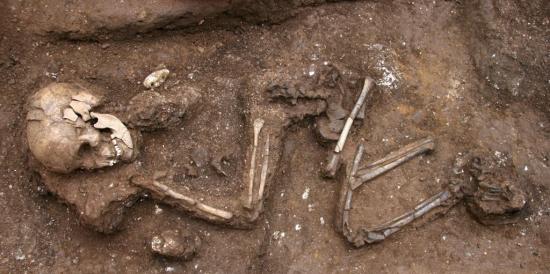James Gorman
Source - http://www.startribune.com/lifestyle/184562391.html?refer=y

An undated handout photo of the skeleton of a young man - Lorna Tilley, New York Times
It is a painful truism that brutality and violence are at least as old as humanity. So, it seems, is caring for the sick and disabled. And some archaeologists are suggesting a closer, more systematic look at how prehistoric people -- who may have left only their bones -- treated illness, injury and incapacitation. Call it the archaeology of health care.
The case that led Lorna Tilley and Marc Oxenham of the Australian National University in Canberra to this idea is that of a profoundly ill young man who lived 4,000 years ago in what is now Vietnam and was buried, as were others in his culture, at a site known as Man Bac.
Almost all the other skeletons at the site, south of Hanoi and about 15 miles from the coast, lie straight. Burial 9, as both the remains and the once-living person are known, was laid to rest curled in the fetal position. When Tilley, a graduate student in archaeology, and Oxenham, a professor, excavated and examined the skeleton in 2007, it became clear why. His fused vertebrae, weak bones and other evidence suggested that he lies in death as he did in life, crippled by disease.
Early caregivers
They gathered that he became paralyzed from the waist down before adolescence, the result of a congenital disease known as Klippel-Feil syndrome. He had little, if any, use of his arms and could not have fed himself or kept himself clean. But he lived another 10 years or so.
They concluded that the people around him who had no metal and lived by fishing, hunting and raising barely domesticated pigs took the time and care to tend to his every need.
"There's an emotional experience in excavating any human being, a feeling of awe," Tilley said, and a responsibility "to tell the story with as much accuracy and humanity as we can."
This case -- and other similar, if less extreme examples of illness and disability -- has prompted them to ask what the dimensions of such a story are, what care for the sick and injured says about the culture that provided it.
The archaeologists described the extent of Burial 9's disability in a paper in Anthropological Science in 2009. Two years later, they returned to the case to address the issue of health care head-on. "The provision and receipt of health care may therefore reflect some of the most fundamental aspects of a culture," they wrote in the International Journal of Paleopathology.
Hints of a caring culture
In the case of Burial 9, Tilley says, not only does his care indicate tolerance and cooperation in his culture, but it suggests that he himself had a sense of his own worth and a strong will to live. Without that, she says, he could not have stayed alive.
"I'm obviously not the first archaeologist" to notice evidence of people who needed help to survive in stone age or other early cultures, she said. Nor does her method come out of the blue. It is based on and extends previous work.
Among archaeological finds, she said, she knows "about 30 cases in which the disease or pathology was so severe, they must have had care in order to survive." And she said there are certainly more such cases to be described.
Such cases include at least one Neanderthal, Shanidar 1, from a site in Iraq, dating to 45,000 years ago, who died around age 50 with one arm amputated, loss of vision in one eye and other injuries. Another is Windover boy from about 7,500 years ago, found in Florida, who had a severe congenital spinal malformation known as spina bifida, and lived to around age 15. D.N. Dickel and G.H. Doran, from Florida State University, wrote the original paper on the case in 1989, and they concluded that contrary to popular stereotypes of prehistoric people, "under some conditions life 7,500 years ago included an ability and willingness to help and sustain the chronically ill and handicapped."
In another well-known case, the skeleton of a teenage boy, Romito 2, found at a site in Italy in the 1980s and dating to 10,000 years ago, showed a form of severe dwarfism that left the boy with very short arms. His people were nomadic and they lived by hunting and gathering. He didn't need nursing care, but the group would have had to accept that he couldn't run at the same pace or participate in hunting in the same way others did.